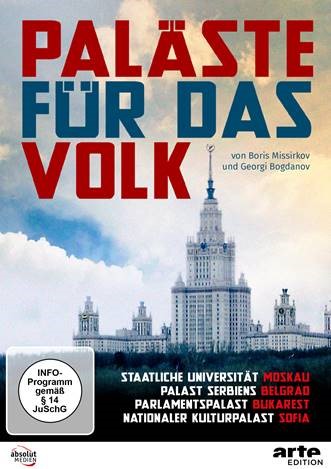In the countries of the former Eastern Bloc, gigantic palaces were built for the people as stone propaganda for the ruling ideology. They are all the largest, the tallest, the most modern in their city, their country or the world. The buildings presented their builders with immense technical challenges, and yet today, after only a few decades, most are already hopelessly outdated. Some palace buildings brought their countries’ economies to the brink of their capacity. The population starved and froze, but to this day has little access to large parts of most of the buildings. Nevertheless, the palaces have become collective reference points, and discussions about their demolition have always met with great indignation.
The series approaches these enormous and fascinating buildings with four examples – three of which will be shown during the theme weekend: The “Palace of Serbia” in Belgrade, the “Palace of Culture” in Sofia and the “Palace of Parliament” in Bucharest. These socialist palaces for the people, built for a revolutionary eternity, have outlived their totalitarian patrons and are now looking for new meaning and use. We meet people who still work in these palaces today or who have close biographical ties to them: They tell us about the stories of their construction, let us trace the megalomania of their clients and understand the change in meaning of the palaces for the people: from the hated monument of a dictatorship to a part of culture, identity and memory. And sometimes also as a nostalgic fixed point on the shaky ground of the present.
The construction of the Palace of Serbia in Belgrade dates back to an order by Marshal Tito, who ordered it in 1947 as the “Palace of Federation” for the Yugoslav unification and as a manifestation of his “own socialist path”. In 1961, the building was opened with the international summit of non-aligned states, of which Yugoslavia was one.
The desire for political independence from the USSR is reflected in the architecture of the H-shaped building: In its modernism, it remains untouched by the influence of Stalinist baroque. The plans were revised and executed by Mihajlo Jankovic, who was influenced by the Bauhaus. Thus, the white marble-clad building in a prime location above the Danube delta still looks contemporary today, especially from the outside. Its interior conveys a timeless elegance thanks to the valuable designer furniture and the completely preserved furnishings from the 1960s. Each of the large salons represents one of the former Yugoslav republics and evokes nostalgic memories of the former socialist federation, which finally dissolved in 2006 when, after 15 years of steady disintegration of Yugoslavia, Montenegro finally also seceded from Serbia. Serbia gave itself a new constitution at that time and symbolically distanced itself from its Yugoslav past. The palace was now completely oversized and many of the 744 office rooms have been empty ever since. Despite its museum qualities, Belgrade’s largest building is not open to the public.
The Palace of Culture in Sofia seems almost moderate compared to the megalomania in the other palaces. It was built in just four years and opened in 1981 to celebrate the 1300th anniversary of Bulgaria’s founding. The driving force behind the project was the daughter of the chairman of the Bulgarian Communist Party, Todor Zhivkov, and then Minister of Culture, Lyudmila Zhivkova. At that time, the pompous culture and congress centre shone with futuristic technology and housed every conceivable art object. Every working person had to donate a day’s wages – whether they wanted to or not – to cushion the immense construction costs. It was deducted from their salary, which added up to almost 15% of the costs. A promotional film from 1980 proudly presents the modern technology: colossal apparatuses with flashing lights, a thousand buttons and keys, walls with circuit diagrams the size of a square metre, entire rows of seats that disappear into the walls as if pulled by magic. Today, the palace seems to be above all a home and museum for its own staff. We meet employees who have spent almost their entire lives here and have survived all the system changes and EU accessions in the seclusion of their hard-to-find workrooms. The renovation costs of the palace, which is fast going out of fashion, are currently being calculated. Bulgaria will take over the EU presidency in 2019 – the renovation work should be completed by then.
Today’s Palace of Parliament in Bucharest used to be called the “House of the People”, but was called the “House of Victory over the People” by the people themselves. 700,000 tons of steel, 550,000 tons of cement and 1 million cubic metres of marble were used. Ceausescu literally starved the population to build the second largest administrative building in the world. Built from 1983 to 1989 according to his ideas, the palace was only completed in 1997, posthumously, so to speak. About a third of the city centre, six synagogues and 22 churches were razed to the ground or moved. 40,000 flats were evicted. History was overwritten, urbanisation was pushed forward at all costs. The building is the megalomania in stone of a former cobbler’s boy who, as head of state, lived out his fantasies of omnipotence and could have entire streets destroyed with a wave of his hand. Archive footage shows the gigantic construction site, teeming with hard-working construction workers. Ceausescu struts between them and surveys the goings-on.
The palace itself is so oversized that people inevitably feel tiny. Even today, the city centre of Bucharest is cut and scarred by Ceausescu’s palace. The fact that Romania’s first democratically elected government moved seamlessly into the domination of the totalitarian Ceausescu is not without controversy. But despite all the memories of oppression, deprivation and expulsion during the construction of this palace of superlatives, people in Bucharest today no longer want to miss it.


